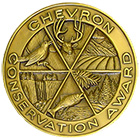Chevron Conservation Award letter from Edward G. Voss, University of Michigan Herbarium, honoring Dr. John H. Tanton
UNIVERSITY OF MICHIGAN HERBARIUM
NORTH UNIVERSITY BUILDING ANN ARBOR, MICHIGAN 48109-1057, U.S.A.
December 7, 1989
Chevron Conservation Awards Committee
Dear Committee:
With great pleasure I write to support the nomination of Dr. John 11. Tantor for a Chevron Conservation Award. In a number of diverse ways I have been privileged to work with him and observe him in action since 1961. The key word here is indeed action, for he has been an effective "mover and shaker" in conservation endeavors.
After receiving his medical degree, John came to Ann Arbor in 1961 to do a residency in ophthalmology, and lie immediately became involved with the Michigan Natural Areas Council (at that time, the Michigan representative of The Nature Conservancy, which did not yet have a chapter in the state). The NINAC was just 10 years old then, a group of citizen volunteers engaged in locating, evaluating and accelerating dedication of natural areas in Michigan, chiefly on state-owned lands (it is not a land-owning organization). In January of 1962, John began two outstanding years of service as secretary of the NNAC. He vigorously talked and corresponded with scientists, state officials, public agencies, and others in our successful efforts to protect some remnants of Michigan's natural heritage. The period might well he regarded as the peak time of effectiveness of the Council, before other organizations, including land-holding ones, began major operations the state. (The Nature Conservancy, the Michigan Natural Features Inventory, the Department of Natural Resources Wilderness & Natural Areas advisory Board, and other groups built on the foundations established by MNAC.)
After removal to Petoskey in 1964, John continued to be active in conservation organizations in Michigan, especially in attempting to define roles, coordinate groups with common interests, and generally get things done. He has always recognized the need for a sound factual basis for evaluation of natural areas and the status of rare species. In northern Michigan, he was soon taking me on some of his excursions to investigate choice Great Lakes shoreline property, a swamp belong to the local community college, and other areas. On his days off in the 1960's he came over to the University of Michigan Biological Station (about 30 miles from Petoskey) to take courses--all of them graduate-level classes in which he could enroll for official credit: Algae, Birds, Pleistocene Geology, Plant Taxonomy, and Aquatic Flowering Plants. The last two listed are mine, in which I know he earned A grade and I suspect his performance in the others was equally fine. Not bad for a busy physician on his days off! (Our Station courses meet for full days, not briefly every day, to allow long field trips.)
Soon, John was busy setting up a land-preservation organization in the Petoskey area, one of the prime movers in the Little Traverse Conservancy, founded in [19xx]. I am now in a second 3-year term on the board of trustees, and we who have seer Little Traverse Conservancy pioneer in protection of choice northwestern Michigan lands through preserve ownership, and now also conservation easements, recognize the extraordinarily fine foundation that Dr. Tanton and his co-workers laid. The LTC is nationally recognized as a dynamic leader among local land trusts and is widely cited in the press and by the Land Trust Exchange.
Knowing the necessity of accurate vouchering of distribution records, John has built up his own herbarium for plant identification reference. Upon moving to Petoskey, he started finding plants rare or previously unknown in the region and collected duplicate specimens for us to verify and retain for the record in our collections. These have been helpful in making the distribution maps more complete in the two volumes (of three projected) thus far published in my "Michigan Flora".
I hove documented some of these earlier activities because they demonstrate John Tanton's lifelong committment and because I was a close witness (sometimes even a co-conspirator); I know that others will be sure to comment on the broader scene, such as John's role in founding of FAIR (Federation for American Immigration, Reform), his presidency of ZPG (Zero Population Growth), and his other public services in accord with the fact that environmental problems cannot be solved if population growth continues uncurbed beyond the carrying capacity of mother Earth. Always it has been John's full understanding of fundamental biological principles of ecology that has undergirded his amazing efforts to make the world a better place and a place better understood by its human but too often inhumane inhabitants.
John is a real live wire, sending memoranda and conies of items he knows will be of interest to his far-flung correspondents, talking to groups, offering suggestions, energizing all of us to do something about our deteriorating planet, including our own backyard. lie not only has the skill and experience to know how to accomplish things, but he also devotes an incredible amount of his time to using those skills and keeping up on his "continuing education." And he knows when it's time to turn an organization loose to thrive without his constant attention, while he goes on to revitalize another.
Surely someone who has dedicated 30 years of his life in such an effective way as has John Tanton is eminently worthy of a distinguished award that recognize his achievements for the cause of conservation!
Sincerely yours,
Edward G. Voss
Curator of Vascular Plants & Professor of Botany

